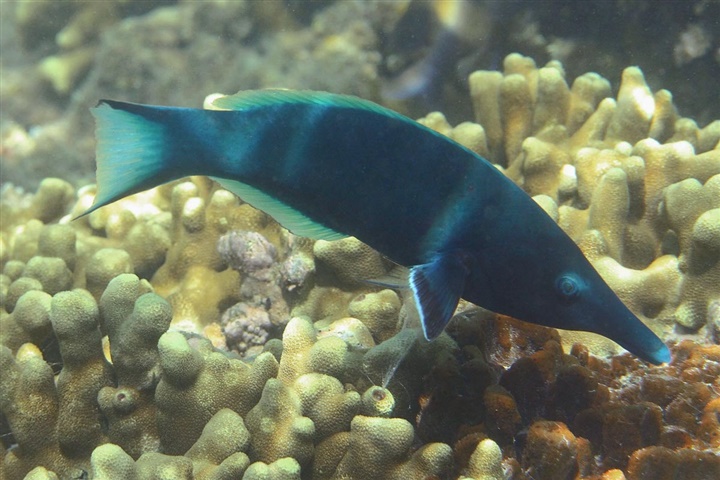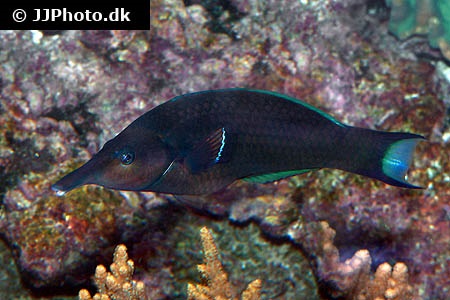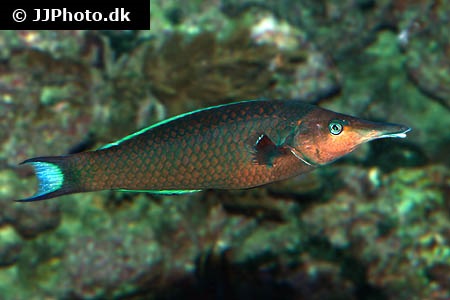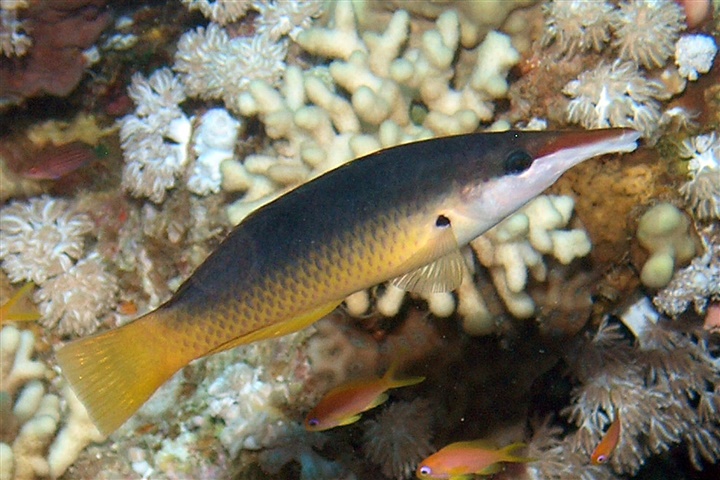Gomphosus caeruleus
| Latin name | Gomphosus caeruleus - Lacepède, 1801 |
|---|---|
| Local name | Green birdmouth wrasse |
| Family | Labridae - Gomphosus |
| Origin | |
| Max length | 32 cm (12.6") |
| Minimum volume |
1000 l (264 gal) |
|---|---|
| Hardiness |
Hardy |
| Suitable for aquarium |
Suitable with care |
| Reef safe |
Reef safe with caution |
| Aggressiveness | Might be aggressive towards similar species |
| Recommended |
Larger crustaceans (Shrimp, crabs...) Other invertebrates Small crustaceans (Krill, mysis, artemia...) |
|---|---|
| Maybee |
Fish |
This species is known to jump out of open aquaria.
This spicies might be a threat to smaller fishes.
This species sometimes nibbles at clams including Tridacna species.
This species will eat shrimps, crabs, small bivalves, snails and the like.
This species must be fed with an appropriately varied diet.
They can live as a pair provided they are introduced simultaneously.
This species needs good hiding places, for example, between live rocks.
This species revels in swimming and requires an aquarium with ample space.
This species can change gender from female to male.
When a male is needed, a female changes sex and takes on the role.
This species can be aggressive when kept together with fish that are very similar, or if they are not provided with adequate space.
Birdwrasses (Gomphusus) are so called because of their special beak-formed jaw, which they use to hunt for prey amongst rock and corals.
They eat mainly crabs, shrimps and crayfish, but also mussels, small fish and starfish are included in their natural diet. If the prey is too large to be eaten whole, these Wrasses will hit it against rocks until the pieces are of the right size.
They normally sleep between rocks.
Wrasses are nearly always seen in reef aquaria, since many of the species are both attractive and useful in battling a range of unwanted invertebrates like i.e. flatworms, pyramide snails.
These fish live of everything from zooplankton to large crustaceans, sea urchins and the like.
The needs and behaviour of Wrasses vary greatly, so it is vital to familiarize oneself with the specific species before buying one.
| Aquarium trade | Yes |
|---|---|
| Distribution | Indian Ocean: East Africa south to Natal, South Africa (Ref. 4392) and east to the Andaman Sea. |
| German common names |
Schnabellippfisch |
| Danish common names |
Indisk fuglegylte |
| English common names |
Indian Ocean bird wrasse Green birdmouth wrasse Bird wrasse Blue green bird wrasse |
| French common names |
Labre oiseau Poisson oiseau |
Bob Fenner. Sociable to the Point of Exuberance! The Bird Wrasses, Genus Gomphosus - Wet Web Media - (English)
James Fatherree. 2014. A look at the Bird Wrasses (Requires subscription) - Tropical Fish Hobbyist Magazine - (English)
Scott W. Michael. 2009. Wrasses and Parrotfishes (Reef Fishes Series Book 5) - TFH Publications / Microcosm Ltd. - (English)





